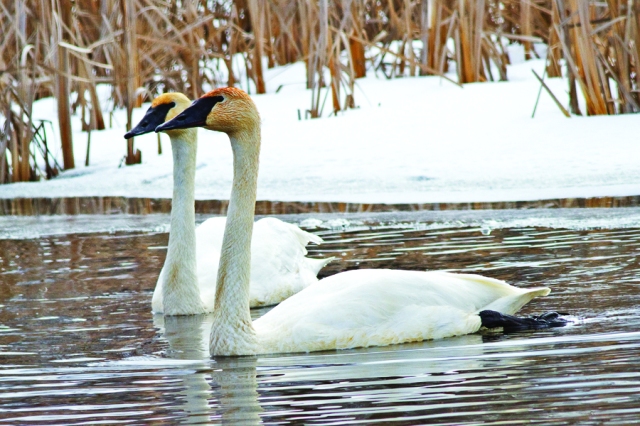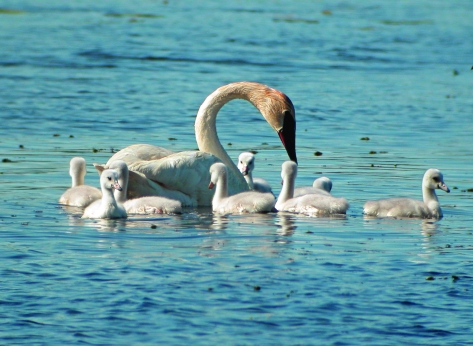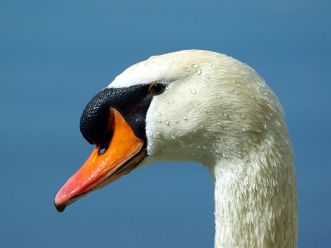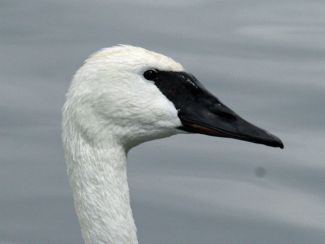
Trumpeter Swans populations are becoming more abundant. Photo by Roger Eriksson.
By Howard Meyerson
Fifty years ago the plight of Trumpeter Swans was a cause for concern in North America. The majestic birds were perched on the brink of extinction. America’s largest waterfowl species was in need of a helping hand.
Today their status has greatly improved due to reintroduction efforts by government wildlife agencies, conservation organizations, Indian tribes, and public utilities. Their numbers have increased across much of the continent. Reintroduction work continues in some locales. But here in Michigan the Trumpeters are doing very well; their recovery is a significant conservation success, according to state officials.
“This still needs to be vetted within the agency, have a public review, and be finalized by the legislature, but we will recommend in the next 12 to 18 months that the Trumpeter Swan be removed from the Michigan Threatened and Endangered Species List,” said Dan Kennedy, the endangered species coordinator for the Michigan Department of Natural Resources. “Their population made a drastic upswing between 2000 and 2010.”
Approximately 756 Trumpeters now inhabit Michigan waters, according to DNR survey records, a dramatic change from none in 1986 when the state’s swan reintroduction efforts began. Michigan’s recovery goal was modest: having two flocks of 100 swans each by year 2000. That goal was reached in 1997, according to Kennedy. It was accomplished by rearing and later releasing two-year-old Trumpeter Swans at select locations around the state.

Trumpeter Swans breeding success continues to be challenged by the presence of Mute Swans on many Michigan waters. Photo by Corey Gildersleeve.
Highest recorded numbers
The U.S. Fish & Wildlife Service 2010 North American Trumpeter Swan Survey, the last available, reports 46,225 Trumpeter Swans were found in North America that year, 33 percent more than 2005 and the highest number since the survey began in 1968. Fewer than 70 were known of in 1933, according to the Trumpeter Swan Society, a nonprofit dedicated to the restoration and conservation of the species. Trumpeters were once abundant all across North America.
“We know they are increasing and they are occupying areas they did not before,” explains Barb Avers, the Michigan DNR’s waterfowl program specialist. “They are still on the state [threated and endangered species] list, but not the Fed list. We don’t anticipate any setbacks [from delisting]. They have been doing well enough on their own…. I think we will continue to see growth as we [further] bring down the mute swan population.”
Mute Swans, which are identified by an orange bill, black face, and bulbous black knob at the base of the bill, are an aggressive swan species

Mute Swans are readily identified by their orange bill and black bulb at the base of their bill. Photo by Christian Jansky, Wikimedia Commons.
known to drive Trumpeter Swans and other waterfowl out of their wetland breeding areas. They are found in every Michigan county, according to Avers. Her agency began a local control program in the 1960s which was stepped-up in recent years with a goal of reducing Michigan’s Mute Swan population to fewer than 2,000 by 2030.
“We’ve had lots of reports about them driving Trumpeters out, and when we remove the Mute Swan, we see Trumpeter Swans nesting,” Avers said. “Fortunately the Mute Swan population is going down. The 2015 state estimate is 8,700 Mute Swans, compared to 2010, when we had 15,000 and began a more intensive effort to remove (i.e., kill) them. Having that many Mute Swans on the landscape was definitely a concern. Trumpeters don’t face that many threats, but that is one.”
Early restoration effort
Michigan’s Trumpeter restoration effort began in 1986 as part of a nationwide restoration effort that had begun two decades before. But the

Trumpeter Swans have an all black bill. Photo by Dick Daniels, Wikimedia Commons.
Trumpeter’s demise dates back to the 1800s when European settlers began clearing land, draining and filling marshes, and the swans were pursued by unregulated market hunters for meat, skins, down, and quills.
Michigan’s swan release program was coordinated by the late Joe Johnson, a biologist and manager for the W.K. Kellogg Bird Sanctuary, part of Michigan State University’s W.K. Kellogg Biological Station, where the program was headquartered. Johnson, who eventually traveled to Alaska to get Trumpeter Swan eggs, is credited with overcoming a number of challenges in the early stages of the reintroduction program that ended in 1993.
“A total of 124 Trumpeters were released as two year olds,” Johnson penned in the 2011 Michigan Breeding Bird Atlas, the year before he died. About a third of the swans were released in the eastern UP, another third in the NLP and the remainder in the southwestern LP. Many of the swans were hatched and reared from eggs collected in Alaska; many others were donated by major zoos and private aviculturists. From 1994 to 2005, 122 more were released in the western UP, northeastern LP, northwestern LP and southeastern LP by Consumers Energy Corporation, Native American tribes, and private citizens. The restoration effort was sponsored by the DNR Nongame program and MSU’s Kellogg Bird Sanctuary.”
“They reared all the eggs, did all the incubation, and it took some trial and effort to figure out whether they could release the swans as two-year-olds when they were ready to mate,” recalls Kara Haas, Science Education and Outreach coordinator for the biological station. “One thing they tried to do early on was incubate trumpeter eggs under mute swans in the wild. It didn’t work. The swans wouldn’t raise them—and they didn’t survive.
“They also had to find release sites where there was no waterfowl hunting, where lead shot was not an issue. And they eventually found that by raising the young swans in family units, they wouldn’t interbreed…It’s pretty encouraging that they did breed and seem to be doing OK.”
Michigan Audubon also had an important role in the swan’s recovery. Three pairs of young Trumpeters were released in 1991 at its Phyllis Haehnle Memorial Sanctuary in Pleasant Lake. One of the swans died that summer and the other two were removed due to sickness, recalls executive director Jonathan Lutz. All three suffered from lead poisoning. But two pairs were introduced that same year at the Bernard W. Baker Sanctuary in Bellevue, home to Michigan Audubon’s annual CraneFest event. That pair remains today and is reproducing.
“It’s remarkable that Baker was one of the original release sites, and we continue to have successful reproduction there,” Lutz said. “I believe that five cygnets fledged there this year. It’s an important spot for them and offers the public an opportunity to see conservation in action.”
_____________________________
Appears in Jack Pine Warbler, Magazine of Michigan Audubon.

The lower White River (Muskegon County at the US-31 freeway) had flooded cornfields with snowmelt and rain during the spring of 2015. For three days the cornfields had a large flock of trumpeter swans resting and feeding. What a beautiful sight. White Lake does have the occasional individual trumpeter swan sightings, but no confirmed nesting. White Lake now has the restored ideal swan wetland habitat available. We just need to remove more of the invasive mute swans.
LikeLiked by 1 person
Agreed with you there, Tom. The mute swans need to go.
LikeLike
I also concur, and think that more people actually seeing trumpeters in MI will help – they will be more likely to be on board with removing (killing) mutes on their waters. I know how I felt the first few times I saw them, and I still get a bit tight in the throat even now. It’ll be a source of pride to have them – it’s “our” swan.
LikeLiked by 1 person
Enjoyed the last two days watching a mature pair on bear lake in bear lake ! First time we’ve seen them
LikeLike
We’ve had trumpeters in our backyard for about 12 years now. I used to give Joe Johnson stats every year (sometimes twice a year) about our pair and their cygnets. We’ve enjoyed having them, we can even hand feed them corn!
LikeLike
Sephanie. Thanks for your comment. They are beautiful birds and I suspect having them in your yard was a treat.
LikeLike
I did not see a clarification in the article that Mute swans are invasive–hence the reason to lower their numbers. I believe they are of European descent.
LikeLike
Mark. Thanks for your comment. They are a non-native species that is considered invasive.
LikeLike
I think Mute Swans are beautiful and have enjoyed see them on our lake! Is this not playing God
by eradicating this beautiful swan just because it is not native originally? I live on Hamlin Lake and
was very upset to learn of their slaughter. Why not incorporate Trumpeter swans on lakes where
Mute swans aren’t.
LikeLike
Mutes are partly domesticated, introduced-by-human birds. It is sometimes necessary to play God if someone acted like the devil earlier. If we remove mutes, trumpeters will “incorporate” themselves. That’s the idea.
LikeLike
I believe I have an excellent location for Trumpeter and would like to find a way to get a pair started. If anyone has a way to connect with someone helping to re-establish or even rehab/recovery for injured birds, I would like to get in contact. Private lake near Rockford/Greenville.
LikeLike
Ironically, I believe the mute swans tend to wipe out the native water plants, causing invasive plants to backfill. I’m all in favor of removing the mutes and supporting the Trumpeters. Here in Ann Arbor, right now on 2/9/2020, we have a big flock of Trumpeters in the faster moving non-frozen parts of the Huron River, downstream from a flock of mutes – and loads of geese and ducks to boot. The mutes are usually pretty aggressive driving others away during the summer, but right now I think there are just too many birds to chase, so the Trumpeters are able to relax a bit by just being a separated a by 50 yards or so with a buffer of other birds in between. What a sound, with so many Trumpeters together! As I ran by, the squawked a bit, not alarmingly but more like a tremolo. Easy to see how the got their name.
LikeLike